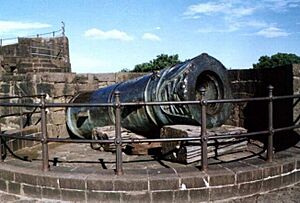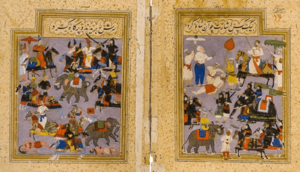Battle of Talikota facts for kids
Quick facts for kids Battle of Talikota |
|||||||
|---|---|---|---|---|---|---|---|
| Part of Deccan sultanates–Vijayanagara conflicts | |||||||
|
|||||||
| Belligerents | |||||||
|
Vijayanagara Empire | ||||||
| Commanders and leaders | |||||||
|
Rama Raya Venkatadri † Tirumala Deva Raya Achutappa Nayak |
||||||
The Battle of Talikota, also known as the Battle of Rakkasagi–Tangadagi, was a very important battle fought on January 23, 1565. It took place between the powerful Vijayanagara Empire and a group of allied kingdoms called the Deccan sultanates. Even though the Vijayanagara army was bigger, they lost badly. This battle led to the defeat and death of Rama Raya, who was the main ruler of the Vijayanagara Empire at the time. The loss caused the Vijayanagara kingdom to fall apart quickly and changed the way politics worked in South India and the Deccan region forever.
Historians find it tricky to know exactly what happened during and right after the battle. This is because old writings about it often tell very different stories. Some people used to think this battle was a big fight between Hindus and Muslims. But most modern historians now say that idea is wrong. They believe the battle was mainly about political power, not religion.
Contents
Why Did the Battle Happen?
Rama Raya became the real ruler of the Vijayanagara Empire. For about twenty years, he used a clever plan: he would help one Sultanate against another to keep his own power strong. This worked well for a long time.
However, things changed when Rama Raya tried hard to control a city called Kalyan. He also had some diplomatic dealings with the Sultanates that were seen as insulting. Because of this, four Muslim Sultanates decided to team up against him. These were:
- Hussain Nizam Shah I and Ali Adil Shah I from Ahmadnagar and Bijapur in the west.
- Ali Barid Shah I from Bidar in the middle.
- Ibrahim Quli Qutb Shah Wali from Golkonda in the east.
They formed an alliance, partly through marriages between their royal families, and decided to attack Rama Raya in late January 1565.
How the Battle Unfolded
The exact place where the battle happened is debated. Some say it was at Talikota, others at Rakkasagi-Tangadigi, or Bannihatti. All these places are near the Krishna River. Even the exact dates of the battle are not fully agreed upon by historians. Some say it lasted only a few hours, while others say it went on for days. Descriptions of how the armies were set up and how they moved also vary.
What Happened to Rama Raya?
During the battle, Rama Raya was captured. He was then killed, either by Sultan Nizam Hussain himself or by someone else on his orders. This happened even though Ali Adil Shah, who had been friendly with Rama Raya, did not want him to be killed.
After Rama Raya's death, there was a lot of confusion. His brother, Tirumala, ran away with the entire army. He tried to gather his forces again in Vijayanagara but failed. So, he moved to areas outside the city. Rama Raya's other brother, Venkatadri, was also killed during the battle.
What Happened After the Battle?

After the battle, the Sultanates' armies marched into Vijayanagara without anyone stopping them. They looted the city. Many old stories and historians used to say that the city of Vijayanagara was completely destroyed and turned into ruins. They believed that holy places were badly damaged.
However, modern historians and archaeologists have questioned this idea. They say there isn't much proof that the whole city was destroyed, especially outside the royal center. They also point out that destroying royal buildings and symbols of power was a common war tactic to show who was in charge.
Even so, the Battle of Talikota caused a huge change for the Vijayanagara kingdom. It completely reshaped the politics of the Deccan region. The building of new monuments and temples stopped, and the worship of the god Vishnu in the city of Vijayanagara ended because the royal family no longer supported it. The royal center of the city was never rebuilt.
The Bijapur Sultanate gained the most from the victory, but their alliance with the other Sultanates did not last long. Rama Raya's brother, Tirumala, later started a new ruling family called the Aravidu dynasty. This dynasty ruled over parts of the old empire. They even stayed in Vijayanagara for two years before moving their capital to Pengonda. But they faced many problems, like arguments over who should rule next, rebellions from local chiefs, and ongoing fights with the Bijapur Sultanate. Because of these challenges, the Aravidu dynasty eventually moved further south and finally broke apart in the late 1640s.
How Historians See the Battle Today
For a long time, some historians, especially during the time when India was ruled by the British, saw the Battle of Talikota as a "Clash of civilizations". They believed it was a fight between Hindu civilization (represented by Vijayanagara) and Islamic civilization (represented by the Deccan Sultanates). In this view, the battle meant the fall of the last major Hindu kingdom in South India to Muslim expansion. Some Indian nationalist historians have also supported this idea.
However, in recent years, many historians have disagreed with this view. For example, Richard M. Eaton says there were no religious reasons behind the battle. He points out that Rama Raya himself made alliances with Muslim rulers at different times, showing that politics, not religion, was the main reason for these actions. He also notes that Islamic art and culture were present and supported in the Vijayanagara kingdom. Also, Rama Raya's successors, the Aravidus, later formed alliances with the heirs of the very same Deccan Sultans who fought at Talikota.
Other historians like Romila Thapar, Burton Stein, and Sanjay Subrahmanyam agree with this idea. They also mention that the Muslim Berar Sultanate did not join the battle, and the Sultanate alliance broke up soon after the war. They highlight that Hindus and Muslims often lived peacefully in the Vijayanagara Empire, and Muslims even held important positions in the royal court. All these points suggest that the battle was more about political power and control than a religious conflict.
See also
- War of the League of the Indies


